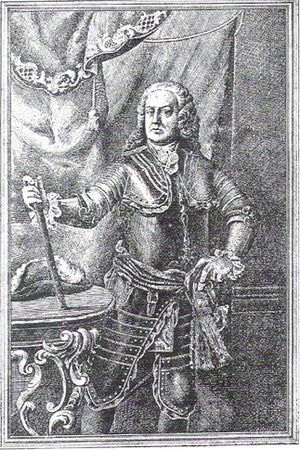Antoni de Villarroel facts for kids
Antonio de Villarroel y Pelaez (born 1656 in Barcelona, died 1726 in A Coruña) was an important Spanish military leader. He first served King Philip V during the War of the Spanish Succession. This was a big war in Europe about who would become the next king of Spain. Later, in 1710, Villarroel changed sides and joined the Habsburgs, supporting Archduke Charles VI. In 1713, he became the main commander of the army in Catalonia.
Contents
Villarroel's Military Journey
Antonio de Villarroel started his army career when he was very young. In 1697, he helped defend the city of Barcelona from a French army.
Fighting in the War of Spanish Succession
When the War of Spanish Succession began, Villarroel first fought for King Philip V. However, after some political changes, he moved to Galicia and joined the side that was against the Bourbon family. Here, he was given an important role as a deputy marshal for Archduke Charles VI.
Leading the Defense of Barcelona
While serving the Habsburgs, Villarroel showed great skill in battles, like the Battle of Villaviciosa. He also managed the difficult task of moving troops out of Aragon in 1711. Because of his achievements, he was made the supreme commander of the forces in Catalonia.
His biggest challenge came when he was put in charge of defending Barcelona during the Siege of Barcelona in 1713-1714. Villarroel had only about 5,000 soldiers, and many of them were local citizens. He had to defend the city against a much larger French and Spanish army of 40,000 soldiers, led by the Duke of Berwick.
As the siege continued through the summer of 1714, the situation in Barcelona became very difficult. Villarroel tried to lead his troops out of the city, but they were stopped by the Duke of Berwick's forces. By September, the attacking army had made a large hole in the city walls. The city leaders asked Villarroel to give up, but he refused to surrender. He kept defending the city until he was injured. After he was hurt, the city officially surrendered to King Philip V's forces.
Despite promises that they would be treated well, Villarroel and 24 other military commanders who defended Barcelona were all taken prisoner.
Imprisonment and Later Life
Villarroel was first held in a castle in Alicante. Later, in 1715, he was moved to A Coruña, where he died on February 22, 1726. He spent his final years in a prison cell that would fill with water when the tide came in. This caused his legs to become completely paralyzed.
For a long time, people thought Villarroel had been released from prison and lived a comfortable life after a peace treaty in 1725. However, in 2009, researchers Josep Catà and Antoni Muñoz discovered the true date and circumstances of his death.
Legacy
Today, a street in the l'Eixample area of modern Barcelona is named after Villarroel.
He is also shown as a hero in the historical novel Victus by Catalan writer Albert Sánchez Piñol. This book is about the War of the Spanish Succession and especially the Siege of Barcelona.
See also
 In Spanish: Antonio de Villarroel para niños
In Spanish: Antonio de Villarroel para niños



